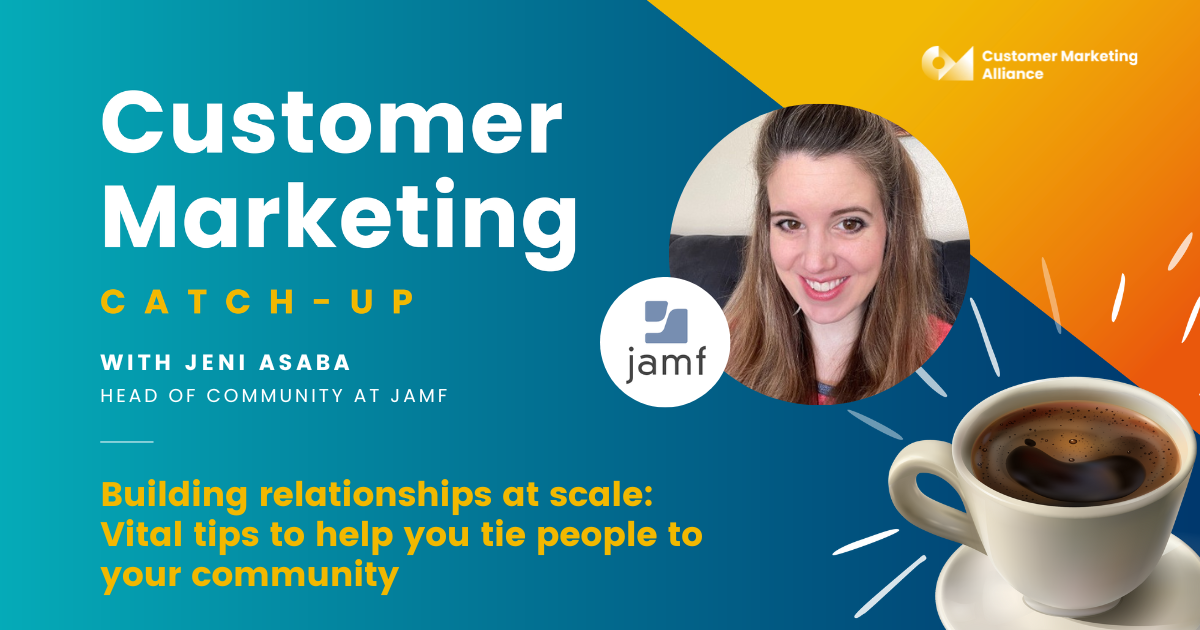Advocacy is the heart of building lasting customer relationships.
I’m Jennifer Susinski, a seasoned customer advocacy expert. My journey into customer advocacy has shaped how I view the essential role it plays in creating genuine connections between brands and customers.
Over the years, I’ve learned that fostering these relationships is about more than just offering a product—it's about providing value, listening to feedback, and creating meaningful experiences that go beyond traditional marketing.
In this article, I’ll share the key lessons and strategies that have helped me successfully build and manage customer advocacy programs, from the importance of personal connection to thinking outside the box and being authentic.
This article was transcribed from a past Customer Marketing Catch-up podcast episode. To listen to the episode instead, look below. 👇

Customer marketing vs advocacy
In the simplest terms, customer advocacy is about the value you bring to your customers beyond the product they pay for. It’s about fostering relationships, whether that’s between them and their peers or with your internal stakeholders.
It’s also about giving them a true seat at the table to help drive your company's innovations and enhancements. After all, who better to learn from about where your product should go than the people actually using it?
I’ve often found that this concept, which seems like a no-brainer to me, can be a real challenge for others to grasp. To bridge this gap, I like to organize "discovery sessions" where we can learn more about our customers.
Historically, I’ve hosted customer days, where we spend four to five hours diving deep into their company’s history, what their team does, and where they want to be in the next one or two years.
These sessions aren’t just about understanding their present needs, but also about helping them move forward—sometimes even helping them find their next job if it’s a good fit within my network.
And let’s not forget to have fun with your customers! Building meaningful connections often means enjoying your time together and participating in activities like charitable events, whether virtual or in person.
Now, when it comes to customer marketing, it’s all about what drives ROI back to your company. This can include case studies, customer testimonials, speaking engagements at events, or taking reference calls. These are the activities that directly support your company's growth.
The continuous effort behind successful customer advocacy
One of the biggest things I wish people knew is that advocacy starts at home. You have to be your customers' advocate first if you expect them to advocate for your program. It takes continuous effort; advocacy is far from a "set it and forget it" type of role.
You’re never going to know everything about your customers, so there’s always room for more conversations, even if it’s just checking in to ask how their weekend was. These small moments can help you understand the person behind the customer, which can be invaluable when navigating future situations with them.
Customers are looking for more than just a product—they genuinely want to form a connection with the brands they purchase from and use every day. So, it’s essential to continuously look for ways to improve their journey from start to finish.
Another key point is that not everything you do will be in your job description. For example, I’m not on the support team, but if a customer reaches out to me saying they’re struggling with support, it’s my responsibility to raise that red flag internally. This can be the difference between a mildly frustrated customer and one who is extremely angry.
Advocacy is a two-way street; if you treat it as one-sided, your customers will quickly drop out of your advocacy funnel.
Lastly, it’s vital to respect the members of your advocacy community. Not everyone is going to advocate in the same way, and you have to honor their time and the "swim lanes" they’re comfortable in.
Every customer has a different comfort level when it comes to advocacy, and you need to meet them where they are.
Leveraging customer engagement to shape community growth
When you're building a community from scratch, it's actually quite simple because you can gather feedback right from the start.
The challenge comes when you're stepping into an established community.
At Talia, I had the opportunity to build a community from scratch, so I already knew my goals as a community manager. The next step was to sit down with stakeholders in the company to understand their goals and figure out how the community could help them achieve those.
Then, I spoke with customers to discover what they wanted to collaborate on with us. With all that feedback in hand, I created a map for a realistic program. It’s important to set high goals and aim for excellence, but you need to ground those goals in the feedback you receive from everyone involved.
On the flip side, when you inherit a community that needs an overhaul, it can be tricky but totally doable. You start by understanding your own goals, then work with the company to see how a better customer community can help meet overall objectives.
From there, I talked to the customers—specifically, I pulled a list of the top 20 customers with the highest engagement points and asked if they were willing to hop on a 30-minute call. I got valuable feedback on how they felt about the community, where they wanted to see it go, and how I could assist them. I took that feedback and intertwined it into the community's redesign, making continuous improvements and asking if things were getting better along the way.
This approach not only helped me shape a stronger community, but it also allowed me to build some incredible relationships.
Back in 2017, after those initial calls, I formed lasting connections with several customers, and even recently, I’ve spoken with seven of them. Many have moved on to other companies, but the relationships we built have endured. That’s a powerful testament to how community building can transcend the boundaries of work—it can create genuine friendships, and those relationships can ultimately benefit both sides in the long run.

The biggest lessons from my career
The first big lesson I’ve learned is that not everyone wants to see you succeed, and that can be a tough pill to swallow.
It's hard when it happens to you, and it's hard to watch it happen to others, but it's important to recognize. When you’re working on something great, your instinct might be to share it with everyone, but sometimes you need to be more guarded. It’s a harsh reality, but learning how to navigate those situations will serve you well in the long run.
The second lesson is: don’t be afraid to think outside the box. Push the envelope, try new things, and have fun while you’re doing it.
At my last company, I had always wanted to do something charitable, but the timing was never right. Eventually, I convinced them to do a charitable match program. If our customers redeemed their points for charitable donations, we’d match those donations.
It was such a rewarding experience—not only for the company but also for our customers. We even created an infographic showcasing the impact, and when one customer saw it, they were genuinely moved by what we’d achieved together. It’s one of those moments that makes you feel like you’ve made a real difference, no matter how small it might seem.
Finally, the third lesson is to just be yourself. This advice came to me from an SVP at a time when I was really nervous about a meeting with high-level executives.
I was six levels below everyone else, and it was intimidating. He simply told me, “Jen, just be yourself. You’re going to knock it out of the park.” At the time, it didn’t feel super helpful, but six months down the road, I realized how right he was.
We all bring different skill sets, backgrounds, and education levels to the table, but if you’re authentic and true to yourself, you can create something amazing together.
Looking for a more in depth way to learn about customer advocacy? We've got an entire course on the topic.
Create game-changing customer experiences for your most valuable customers that drive business growth and career momentum and get certified today.






